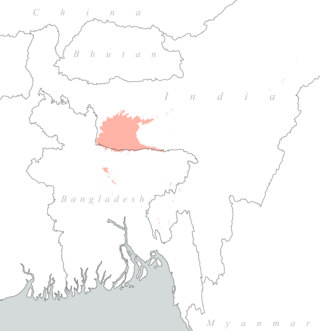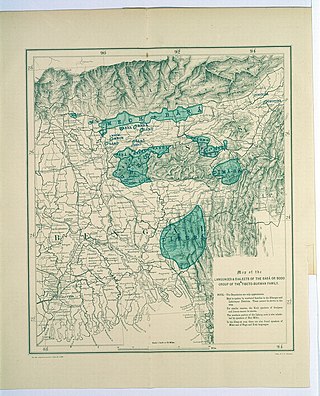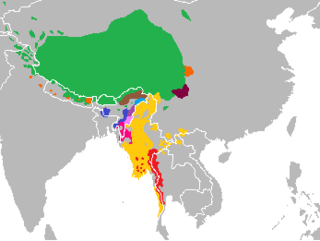
Sino-Tibetan is a family of more than 400 languages, second only to Indo-European in number of native speakers. Around 1.4 billion people speak a Sino-Tibetan language. The vast majority of these are the 1.3 billion native speakers of Sinitic languages. Other Sino-Tibetan languages with large numbers of speakers include Burmese and the Tibetic languages. The four UN member states China, Singapore, Myanmar, and Bhutan have a Sino-Tibetan language as their main native language. Other languages of the family are spoken in the Himalayas, the Southeast Asian Massif, and the eastern edge of the Tibetan Plateau. Most of these have small speech communities in remote mountain areas, and as such are poorly documented.
A.tong is one of the Garo dialect Sino-Tibetan language which is also related to Koch, Rabha, Bodo other than Garo language. It is spoken in the South Garo Hills and West Khasi Hills districts of Meghalaya state in Northeast India, southern Kamrup district in Assam, and adjacent areas in Bangladesh. The spelling "A.tong" is based on the way the speakers themselves pronounce the name of their language. There is no glottal stop in the name and it is not a tonal language.
Koch is a Sino-Tibetan language spoken by the Koch people of India and Bangladesh. It is primarily spoken in the Indian states of Meghalaya, West Bengal, and Lower Assam and in the northen parts of the country Bangladesh, where it serves as a major means of communication among the Koches and other ethnic groups in the region. Koch language is written with Assamese, Bengali, Roman scripts.

Garo, also referred to by its endonym A·chikku, is a Tibeto-Burman language spoken in the Northeast Indian states of Meghalaya, Assam, and Tripura. It is also spoken in certain areas of the neighbouring Bangladesh. According to the 2001 census, there are about 889,000 Garo speakers in India alone; another 130,000 are found in Bangladesh.

Bodo–Kacharis is a name used by anthropologist and linguists to define a collection of ethnic groups living predominantly in the Northeast Indian states of Assam, Tripura, Meghalaya and West Bengal. These peoples are speakers of either Bodo–Garo languages or Assamese. Some Tibeto-Burman speakers who live closely in and around the Brahmaputra valley, such as the Mising people and Karbi people, are not considered Bodo–Kachari. Many of these peoples have formed early states in the late Medieval era of Indian history and came under varying degrees of Sanskritisation.

Kachari is a Sino-Tibetan language of the Boro-Garo branch that is spoken in Assam, India. With fewer than 60,000 speakers recorded in 1997, and the Asam 2001 Census reporting a literacy rate of 81% the Kachari language is currently ranked as threatened. Kachari is closely related to surrounding languages, including Tiwa, Rābhā, Hajong, Kochi and Mechi.
Baima is a language spoken by 10,000 Baima people, of Tibetan ethnicity, in north-central Sichuan Province and Gansu Province, China. Baima is passed on from parents to children in Baima villages. It is spoken within the home domain and is not used in any media of mass communication.
The Lai people mainly inhabit the southern parts of Chin Hills in Myanmar's Chin State, in the townships of Falam, Thantlang and Hakha. They are also found in the Lawngtlai district of Mizoram, India, where they have been granted the Lai Autonomous District Council. Outside this area they are scattered in Mizoram and in Manipur. Their languages "Laizo Lai" and "Hakha Lai" are classified as Central Kuki-Chin languages.
The Boro–Garo languages are a branch of Sino-Tibetan languages, spoken primarily in Northeast India and parts of Bangladesh.
The Konyak languages, or alternatively the Konyakian, Northern Naga, or Patkaian languages, is a branch of Sino-Tibetan languages spoken by various Naga peoples in southeastern Arunachal Pradesh and northeastern Nagaland states of northeastern India. They are not particularly closely related to other Naga languages spoken further to the south, but rather to other Sal languages such as Jingpho and the Bodo-Garo languages. There are many dialects, and villages even a few kilometers apart frequently have to rely on a separate common language.
The Koch languages are a small group of Boro-Garo languages a sub-branch of the Sino-Tibetan languages spoken in Northeast India. Burling (2012) calls this the "Rabha group". They are:
The Tibeto-Kanauri languages, also called Bodic, Bodish–Himalayish, and Western Tibeto-Burman, are a proposed intermediate level of classification of the Sino-Tibetan languages, centered on the Tibetic languages and the Kinnauri dialect cluster. The conception of the relationship, or if it is even a valid group, varies between researchers.

The Tibeto-Burman languages are the non-Sinitic members of the Sino-Tibetan language family, over 400 of which are spoken throughout the Southeast Asian Massif ("Zomia") as well as parts of East Asia and South Asia. Around 60 million people speak Tibeto-Burman languages. The name derives from the most widely spoken of these languages, Burmese and the Tibetic languages, which also have extensive literary traditions, dating from the 12th and 7th centuries respectively. Most of the other languages are spoken by much smaller communities, and many of them have not been described in detail.

ʼOle, also called ʼOlekha or Black Mountain Monpa, is a possibly Sino-Tibetan language spoken by about 1,000 people in the Black Mountains of Wangdue Phodrang and Trongsa Districts in western Bhutan. The term ʼOle refers to a clan of speakers.
Megam is one of the Garo dialects in Garo Hills and And in Khasi Hills which is a part of Sino-Tibetan language spoken in Mymensingh and in Kalmakanda subdistrict, Netrokona district, Mymensingh division, Bangladesh. It is a sub-language of Garo and it is closely related to Garo, but has been strongly influenced by Khasian languages, to the extent that it is only 7–9% lexically similar to A’being, the neighboring Garo dialect, but 60% similar to the Khasian language Lyngngam. Lyngngam are also a part of Megam tribe. Lynngam people in Khasi Hills after prolonged exposure to Khasi traditions and customs have adopted a Khasi Identity.
Rabha is a Sino-Tibetan language of Northeast India. The two dialects, Maituri and Rongdani, are divergent enough to cause problems in communication. According to U.V. Joseph, there are three dialects, viz. Róngdani or Róngdania, Mayturi or Mayturia and Songga or Kocha. Joseph writes that "the Kocha dialect, spoken along the northern bank of the Brahmaputra, is highly divergent and is not intelligible to a Róngdani or Mayturi speaker". Joseph also writes that "[t]he dialect variations between Róngdani and Mayturi, both of which are spoken on the southern bank of the Brahmaputra, in the Goalpara district of Assam and belong to the northern slopes of Meghalaya, are minimal". He concludes the paragraph on dialectal variation with: "The Róngdani-Mayturi dialectal differences become gradually more marked as one moves further west".

Aimol, also known as Aimual, is a Sino-Tibetan language spoken by the Aimol people of Manipur, India. It is considered endangered and has less than 9,000 speakers worldwide as per 2011 census. The speakers of this language use Meitei language as their second language (L2) according to the Ethnologue.
Mruic or Mru–Hkongso is a small group of Sino-Tibetan languages consisting of two languages, Mru and Anu-Hkongso. Their relationship within Sino-Tibetan is unclear.

The Dimasa Kachari plains tribe of Cachar are known as Barman, forming one of the indigenous tribes of undivided Cachar. The Dimasas, inhabiting in the Cachar district are officially recognized as one of the Scheduled Tribes under the plains category in Assam in the name called “Barmans in Cachar”.









